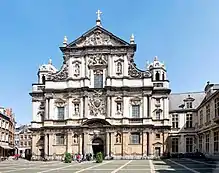| St Charles Borromeo church | |
|---|---|
| Church of St Charles Borromeo | |
Sint-Carolus Borromeuskerk | |
 The Baroque front on the Hendrik Conscienceplein. | |
| 51°13′15.8″N 4°24′16.1″E / 51.221056°N 4.404472°E | |
| Location | Antwerp |
| Country | Belgium |
| Denomination | Catholic |
| Website | top |
| History | |
| Former name(s) | St Ignatius Loyola |
| Status | parish church (since 1803) |
| Founder(s) | Jacobus Tirinus |
| Dedication | St Charles Borromeo |
| Dedicated | 1779 (rededication) |
| Consecrated | 1625 |
| Architecture | |
| Functional status | Active |
| Heritage designation | protected monument (built heritage) |
| Designated | 1939 |
| Architect(s) | Pieter Huyssens, François d'Aguilon |
| Style | Baroque |
| Years built | 1615-1621 |
| Completed | 1626 |
| Closed | 1773 |
| Specifications | |
| Spire height | 58 metres (190 ft) |
| Administration | |
| Province | Mechelen-Brussels |
| Diocese | Antwerp |
| Clergy | |
| Priest(s) | Hendrik Hoet |
St. Charles Borromeo Church (Dutch: Sint-Carolus Borromeuskerk) is a church in central Antwerp, located on the Hendrik Conscience square. It was built in 1615-1621 as the Jesuit church of Antwerp, which was closed in 1773. It was rededicated in 1779 to Saint Charles Borromeo. The church was formerly known for 39 ceiling pieces by Rubens that were lost in a fire when lightning struck the church on 18 July 1718.
History
The church was inspired by the Church of the Gesu, the mother church of the Society of Jesus, a Roman Catholic religious order also known as the Jesuits.[1] The church was built next to the Huis van Aecken, bought from the heirs of Erasmus II Schetz. It was the first church in the world to be dedicated to the Jesuit founder, Ignatius Loyola.
In 1617-1618 Rubens painted two altarpieces. He was also commissioned to paint the ceiling pieces, for which he made the designs while the execution was done mostly by pupils, including Anthony van Dyck.[2] A contract was drawn up in 1620 by Jacobus Tirinus and the paintings were delivered a year later in time for the consecration.[2] Rubens received 7,000 guilders for his works in the church, and though the lavish decorations including sculptures and other artwork were well received, Tirinus was dismissed in 1625 for going beyond his budget.[2]
In 1718 the vault of the nave, including Rubens' ceiling paintings, was destroyed by fire. Jan Pieter van Baurscheidt the Elder restored the damaged parts according to the original plan, but replaced the original coffers with wide transverse arches. In 1773 the Society of Jesus was suppressed and the building was confiscated. It reopened in 1779, renamed St.-Carolus Borromeuskerk, after Charles Borromeo.
Since 1803 the St.-Carolus Borromeuskerk has been in use as a parish church.[1] During the Dutch reign preceding Belgium's independence in 1830 the baroque interior was sobered to make it a Protestant church.
A restoration campaign in the 1980s brought back the churches baroque splendor. Besides works by Rubens the interior displays paintings by Gerard Seghers, Daniel Seghers, and Cornelis Schut.[1]
On 30 August 2009 fire broke out again, but none of the important artworks were damaged.[3]
Gallery
 Painting of the interior by Sebastiaen Vrancx, c. 1630
Painting of the interior by Sebastiaen Vrancx, c. 1630 Painting of the interior by Hieronymus Janssens and Wilhelm Schubert van Ehrenberg, c. 1660
Painting of the interior by Hieronymus Janssens and Wilhelm Schubert van Ehrenberg, c. 1660 Painting of the façade by Anton Gunther Ghering, c. 1665
Painting of the façade by Anton Gunther Ghering, c. 1665 Interior of the church showing the state before the fire by Jacob Balthasar Peeters, 1721
Interior of the church showing the state before the fire by Jacob Balthasar Peeters, 1721 Interior of the church showing the state before the fire by Jacob Balthasar Peeters, 1721
Interior of the church showing the state before the fire by Jacob Balthasar Peeters, 1721 Church interior as it appeared in 2023
Church interior as it appeared in 2023 Church altar, including altarpiece by Rubens
Church altar, including altarpiece by Rubens The church's pulpit, carved by Jan Pieter Van Baurscheit the Elder after the 1718 fire
The church's pulpit, carved by Jan Pieter Van Baurscheit the Elder after the 1718 fire The church interior is decorated with ornate wooden carvings, such as these four angels on the left side of the main hall
The church interior is decorated with ornate wooden carvings, such as these four angels on the left side of the main hall Scenes from the life of St. Francis Xavier on the interior of the church.
Scenes from the life of St. Francis Xavier on the interior of the church.
See also
References
- 1 2 3 Sint-Carolus Borromeuskerk, Sodaliteit en Professenhuis at the Belgian heritage register (in Dutch)
- 1 2 3 Rubens: A Genius at Work : the Works of Peter Paul Rubens in the Royal Museums of Fine Arts of Belgium reconsidered. by Joost Vander Auwera, Sabine van Sprang, Véronique Bücken, Arnout Balis, Nora De Poorter, Nico van Hout, Christine Van Mulders, Michèle Van Kalck and by members of the Rubens project team (Hélène Dubois, Natasja Peeters, Bert Schepers and Tine Meganck).
- ↑ Lichtspots oorzaak van brand Carolus Borromeuskerk (Spotlights cause fire in Carolus Borromeuskerk), www.demorgen.be, September 20, 2009 (in Dutch)
External links
 Media related to Sint-Carolus-Borromeuskerk (Antwerp) at Wikimedia Commons
Media related to Sint-Carolus-Borromeuskerk (Antwerp) at Wikimedia Commons
